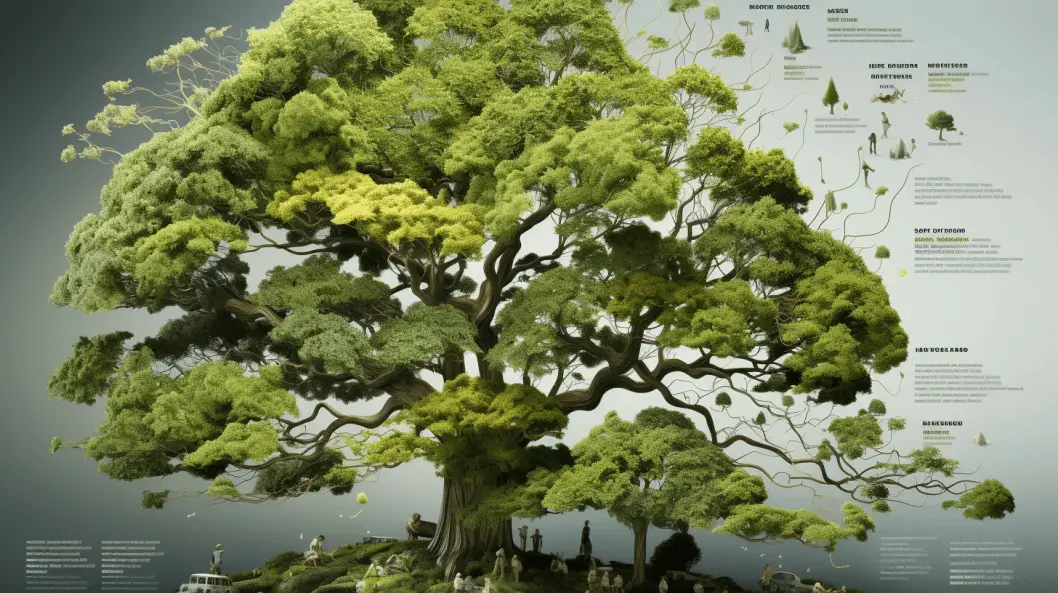This article presents a comprehensive manual on tree risk assessment in PDF format.
The manual aims to provide a detailed understanding of assessing potential tree risks. It covers various aspects, such as pre-assessment considerations, site survey considerations, soil and drainage conditions, and other environmental factors.
Additionally, it explores the impact of climate change on trees, tree biology, growth characteristics, and risks to clients, visitors, staff, and property owners.
The manual is intended to be a valuable resource for tree management and risk assessment professionals.

Definition of Tree Risk Assessment
The purpose of the tree risk assessment manual is to provide a comprehensive guide for assessing and managing risks associated with trees.
It aims to assist arborists, tree care professionals, and land managers in making informed decisions regarding tree safety and risk mitigation.
The manual covers various aspects of tree risk assessment, including identifying potential hazards, assessing tree structure and health, and implementing appropriate management strategies.
Purpose of the Manual
One of the key objectives of this manual is to provide a comprehensive understanding of the purpose of tree risk assessment.
The tree risk assessment manual is a valuable tool in the risk assessment process, guiding arborists and other professionals through the critical steps involved.
It serves as a step-by-step guide, offering a systematic approach to tree risk assessment.
The manual is a desktop reference, providing information and a reliable reference for writing reports.
It covers various aspects of tree risk assessment, including identifying and evaluating common wood decay fungi and the different assessment levels.
Overview
The risk assessment is an essential component of tree management and involves evaluating trees’ potential hazards. A structured approach to tree risk assessment provides a systematic framework for identifying, assessing, and managing tree-related risks.
This approach ensures that a comprehensive evaluation is conducted, considering factors such as tree health, structural integrity, and environmental conditions, to effectively prioritize and mitigate potential risks.
The Risk Assessment Process
Conducting a thorough risk assessment process is crucial for evaluating the potential hazards associated with trees. This process involves a structured approach to identify, assess, and manage risks. Here are four key steps in the tree risk assessment process:
- Tree Inspection: A visual inspection of the tree is conducted to identify any visible defects or signs of decay.
- Risk Assessment Terms: Various risk assessment terms, such as likelihood and consequence, are used to quantify the level of risk associated with a particular tree.
- Trees for Risk: Trees are evaluated based on location, species, condition, and potential impact on people or property.
- Tree Risk Assessment Form: A tree risk assessment form documents the assessment findings, including the identified risks and recommended actions.
References:
- ‘Tree Risk Assessment Manual’ by the International Society of Arboriculture.
- ‘Tree Risk Assessment: A Comprehensive Approach’ by Julian Dunster and Ed Hayes.
A Structured Approach to Tree Risk Assessment
A structured approach to evaluating potential hazards associated with trees involves a systematic process of identifying, assessing, and managing risks. This process is particularly important for novice risk assessors who may not have extensive experience evaluating tree risks.
To assist in this process, a glossary of risk assessment terminology can be helpful in understanding and communicating risk factors to clients. Additionally, incorporating colour illustrations can aid in visualizing the potential hazards and outcomes of tree risks.
Understanding tree biology is also crucial in accurately assessing and managing tree-associated risks. Novice risk assessors can successfully assess and reduce potential risks to their clients and the environment by following a structured approach and utilizing their available resources.
| Risk Identification | Risk Assessment | Risk Management |
|---|---|---|
| Risk Identification | Risk Assessment | Risk Management |
| – Identify potential hazards associated with trees | – Assess the likelihood and consequences of these hazards | – Develop strategies to mitigate or eliminate risks |
| – Collect relevant information such as tree species, condition, and location | – Determine the level of risk based on the likelihood and consequences | – Implement appropriate measures to reduce the identified risks |
| – Consider factors such as tree size, proximity to targets, and prevailing weather conditions | – Use a systematic approach to evaluate and prioritize risks | – Regularly monitor and reassess risks to ensure ongoing safety |
Pre-Assessment Considerations
This discussion will focus on three important pre-assessment considerations: legal, health and safety, and environmental.
When conducting a tree risk assessment, it is crucial to consider the legal obligations and regulations that may apply to the assessment process.
Additionally, ensuring the health and safety of the assessors and the individuals in the surrounding area is of utmost importance.
Lastly, the potential impact of the assessment on the environment, including the ecosystem and biodiversity, should be carefully evaluated.
Legal Considerations
Legal considerations are an essential component when assessing the risks associated with trees. Understanding the legal implications of tree risk assessment is crucial for ensuring compliance with relevant regulations and minimizing liability.
Here are some key legal considerations to keep in mind:
- Property ownership: Determine who owns the property where the tree is located and who is responsible for its maintenance.
- Duty of care: Understand the legal obligation to take reasonable measures to prevent harm caused by trees on your property.
- Local regulations: Familiarize yourself with local laws, ordinances, or permits that may govern tree removal, pruning, or maintenance activities.
- Liability insurance: Ensure you have adequate liability insurance coverage to protect against any potential damages or injuries related to tree-related incidents.
Health & Safety Considerations
In addition to legal considerations, health and safety are crucial aspects to be considered in tree risk assessment. The safety of individuals who may interact with trees, such as property owners, pedestrians, and workers, must be prioritized.
Health and safety considerations encompass various factors, including the tree’s physical condition, structural defects, and the potential for tree failure.
It is essential to assess the tree’s overall health, including signs of decay, disease, or pest infestation, as these can weaken the tree’s structure and increase the risk of failure.
Additionally, factors such as tree location, proximity to infrastructure, and the potential for falling branches or debris should also be evaluated to ensure the safety of the surrounding environment.
Environmental Considerations
Environmental considerations play a significant role in tree risk assessment. They involve assessing factors such as ecological impact, habitat preservation, and the potential for tree removal to affect the surrounding environment.
These considerations are essential for ensuring that tree management activities do not harm the natural ecosystem and contribute to overall environmental sustainability.
Some key environmental considerations in tree risk assessment include:
- Ecological impact: Assessing how the removal or management of a tree may impact the local ecology, including the potential loss of habitat for wildlife species.
- Habitat preservation: Evaluating the importance of the tree in providing habitat for endangered or protected species and considering alternative measures to preserve the habitat.
- Biodiversity conservation: Considering the tree’s contribution to biodiversity and how its removal or management may affect the overall biodiversity of the area.
- Ecosystem services: Identifying the tree’s role in providing ecosystem services such as air purification, carbon sequestration, and stormwater management and evaluating the potential consequences of its removal on these services.
Site Survey Considerations
Site survey considerations are crucial in assessing tree risk and determining the potential hazards associated with trees in a given area. When conducting a site survey, it is important to consider factors affecting tree stability and the likelihood of failure.
These factors include site characteristics, such as soil conditions, topography, and drainage patterns. Additionally, the condition and health of the tree should be evaluated, including signs of decay, disease, or damage. Structural defects, such as cracks, cavities, or weak branch attachments, should also be assessed.
Furthermore, the proximity to targets, such as buildings, roads, or power lines, should be considered. By considering these various site survey considerations, a comprehensive assessment of tree risk can be conducted, leading to informed decision-making and potential hazard mitigation strategies.
Soil and Drainage Conditions
Soil and drainage conditions are important factors to consider when evaluating the stability of trees and assessing the potential hazards they may pose.
The characteristics of the soil, such as its texture, structure, and compaction, can significantly impact the tree’s root system and overall stability.
Additionally, drainage conditions play a crucial role in tree health and stability. Poor drainage can lead to waterlogged soil, weakening the root system and increasing the risk of tree failure.
To assess soil and drainage conditions, the following factors should be considered:
- Soil texture and composition.
- Soil structure and compaction.
- Soil moisture content.
- Drainage patterns and waterlogging.
Evaluating these factors can provide valuable insights into trees’ overall health and stability, helping arborists and professionals make informed decisions regarding tree risk assessment and management.
Other Environmental Factors
Temperature fluctuations can impact the growth and development of trees, as extreme heat or cold can affect physiological processes and increase the risk of damage or mortality. Trees have specific temperature requirements for optimal growth, and deviations from these requirements can have negative effects.
For instance, extreme heat can cause water stress and reduce photosynthesis rates, decreasing growth and productivity. On the other hand, extreme cold can disrupt cellular processes, such as water transport and metabolism, and can lead to frost damage or even death.
Additionally, temperature fluctuations can influence the timing of developmental stages, such as bud burst and leaf senescence, which can affect the overall health and productivity of trees. Therefore, understanding and managing temperature fluctuations is crucial in maintaining the health and vitality of tree populations.
Climate Change and Trees
Climate change poses significant challenges to tree populations’ long-term survival and health. It can lead to alterations in precipitation patterns, increased frequency and intensity of extreme weather events, and shifts in temperature regimes. These changes can profoundly affect trees’ growth, reproduction, and fitness.
The impacts of climate change on trees are complex and multifaceted, with both direct and indirect effects. Some key effects include changes in tree phenology, such as altered timing of bud burst and leaf senescence. These changes can disrupt important ecological processes and relationships.
Additionally, climate change can increase the susceptibility of trees to pests and diseases. Certain pests and pathogens may thrive as temperatures and moisture conditions change, leading to increased damage and mortality in tree populations.
Climate change can also result in range shifts and changes in species composition. As temperatures warm, some tree species may be unable to survive in their current habitats and may need to migrate to more suitable areas. This can lead to shifts in the composition and structure of forests.
Furthermore, climate change can reduce the capacity of trees to sequester carbon. Trees play a crucial role in absorbing carbon dioxide from the atmosphere and storing it in their biomass. However, as climate conditions change, the ability of trees to capture and store carbon may be compromised.
Understanding and predicting the impacts of climate change on trees is crucial for effective forest management and conservation efforts. Ongoing research and monitoring are essential to develop strategies to mitigate these impacts and ensure the long-term survival of tree populations in a rapidly changing climate.

Tree Biology and Growth Characteristics
Various factors, including nutrient availability, water availability, and light conditions, influence tree biology and growth characteristics.
Nutrient availability plays a crucial role in the growth and development of trees. Essential nutrients such as nitrogen, phosphorus, and potassium are required in adequate amounts for proper tree growth. Insufficient nutrient availability can result in stunted growth, nutrient deficiencies, and increased susceptibility to diseases and pests.
Water availability is another important factor that affects tree growth. Adequate water supply is essential for photosynthesis, nutrient uptake, and tree metabolic processes. Insufficient water availability can lead to wilting, reduced growth, and increased vulnerability to stress.
Light conditions also play a significant role in tree growth. Trees require sufficient light for photosynthesis, essential for energy production and growth. Shade-tolerant species can adapt to lower light conditions while light-demanding species require high light levels for optimal growth.
Understanding these factors is crucial for managing and maintaining healthy tree populations.
Risks to Clients, Visitors, Staff and Property Owners
The safety and well-being of clients, visitors, staff, and property owners can be influenced by various factors that must be assessed and managed effectively.
These risks may arise from trees and vegetation in the vicinity. Identifying and addressing potential hazards is crucial to prevent accidents or injuries.
Some key factors to consider include:
- Tree condition: Assessing trees’ health and structural stability is essential to determine if they pose any risk.
- Location: Trees near high-traffic areas or structures may present a greater risk to people and property.
- Tree species: Different tree species have varying characteristics that may affect their potential to cause harm.
- Environmental factors: Weather conditions, such as wind and heavy rainfall, can increase the likelihood of tree failure.
Frequently Asked Questions
Are Any Legal Requirements or Regulations Need to Be Considered During Tree Risk Assessments?
Legal requirements and regulations should be considered during tree risk assessments. These may vary by jurisdiction and can include environmental protection laws, municipal bylaws, and health and safety regulations.
Compliance with these requirements is essential to ensure proper risk assessment and management.
What Are Some Common Signs or Indicators of Tree Risk That Should Be Looked Out for During Assessments?
Common signs or indicators of tree risk that should be looked out for during assessments include visible decay or cavities, cracks in the trunk or branches, leaning or unbalanced structure, dead or hanging branches, and root damage or instability.
How Can Tree Risk Assessments Help Determining Appropriate Maintenance or Management Actions for Trees?
Tree risk assessments aid in determining the appropriate maintenance or management actions for trees by identifying potential hazards and assessing the likelihood and severity of associated risks.
This information guides decision-making and helps prioritize actions to mitigate risks and preserve tree health and safety.
What Are the Potential Consequences of Not Conducting Regular Tree Risk Assessments?
The potential consequences of not conducting regular tree risk assessments include an increased risk of tree failure, which can lead to property damage, injury, or loss of life.
Regular assessments can help identify and mitigate potential hazards.
Are Any Specific Tree Species Known to Pose Higher Risks in Terms of Tree Failure or Damage?
Certain tree species have been identified as posing higher risks of tree failure or damage.
These species often display weak wood, shallow roots, or susceptibility to certain pests or diseases, making them more prone to failure.

Conclusion
The tree risk assessment manual provides a comprehensive guide to assessing the potential risks associated with trees.
It covers various aspects, including pre-assessment considerations, site survey considerations, soil and drainage conditions, and other environmental factors.
Additionally, the manual explores the impact of climate change on trees and delves into tree biology and growth characteristics.
To ensure the safety of clients, visitors, staff, and property owners, tree professionals need to identify and understand potential risks and take appropriate measures to mitigate them. This will help to prevent hazards effectively.

Chris Ekai is a Risk Management expert with over 10 years of experience in the field. He has a Master’s(MSc) degree in Risk Management from University of Portsmouth and is a CPA and Finance professional. He currently works as a Content Manager at Risk Publishing, writing about Enterprise Risk Management, Business Continuity Management and Project Management.

